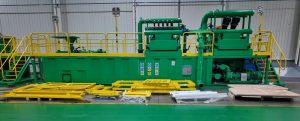Recently, GN Separation successfully delivered two sets of 240 m³/h trenchless mud treatment systems to a customer in Australia. Each system is designed to efficiently process drilling and trenchless construction mud, ensuring effective recycling and reuse.
Each System Includes:
-
One 11.5 m mud tank
-
Two desander cyclones
-
Ten 5-inch desilter cyclones
-
Three sand pumps
-
One mixing hopper
-
One agitator
These systems are designed for trenchless drilling and horizontal directional drilling (HDD) projects, where efficient solids control and fluid recovery are critical for cost reduction and environmental compliance.
Double-Deck Vibrating Screens — The Core Equipment
Each mud treatment system is equipped with two double-deck vibrating screens, which serve as the key equipment for primary solids separation. The vibrating screens remove large solids from the drilling mud, ensuring that the downstream desander and desilter units receive mud with lower solids content, thus improving the overall separation performance.
Technical Features
The double-deck vibrating screen shares design concepts with GN’s high-performance vibrating screen range, as described on GN Solids Australia’s website. The main technical features include:
-
Double-Deck Structure:
Two screening decks are driven by a single vibration source, providing larger screening area and enabling two-stage separation or finer solids removal within limited space. -
Linear Vibration Motion:
The screen box operates in a linear motion pattern, ensuring efficient material conveyance and effective solids discharge. This motion type is ideal for treating slurry and liquid-solid mixtures. -
High-Quality Polyurethane (PU) Screens:
PU screens offer excellent wear resistance, elasticity, and self-cleaning properties. The high open area (typically 28–45%) ensures efficient screening while minimizing blinding. -
Compact and Space-Saving Design:
The double-deck design allows higher processing capacity within a smaller footprint — an important advantage at job sites with limited space. -
Dual-Motor Self-Synchronization Drive:
Two vibration motors work in self-synchronization to ensure stable operation and uniform vibration, reducing maintenance and energy consumption. -
Anti-Corrosion and Wear-Resistant Surface Treatment:
The screen box is treated with sandblasting, heavy-duty anti-corrosion coating, and a polyurea wear layer on surfaces exposed to mud, ensuring long service life in harsh field environments.
Application Advantages in This Project
The inclusion of double-deck vibrating screens in this system offers several operational benefits:
-
Higher Primary Solids Removal Efficiency:
Coarse solids are quickly separated, reducing the solids loading on the desander and desilter units, and improving the overall treatment performance. -
Reduced Footprint and Structural Height:
Compared with two single-layer screens, the double-deck design saves space while maintaining large screening capacity — ideal for compact trenchless job sites. -
Stable and Continuous Operation:
Linear motion and flexible PU screens prevent blinding and ensure consistent performance, minimizing downtime and maintenance needs. -
Energy Efficiency and Easy Maintenance:
The simple structure, synchronized drive, and long-lasting screens help reduce operational and maintenance costs. -
Customizable Design:
The vibrating screen can be customized based on the site’s mud properties (solid content, particle size distribution, viscosity, etc.) by adjusting screen mesh size, vibration amplitude, and feeding mechanism.
Technical Reference
While this project uses double-deck vibrating screens, their design principles align with GN’s multi-deck (2–5 layers) vibrating screens, as shown on the GN Separation official website:
-
Screen angle: 17.5°
-
Vibration frequency: ~25 Hz
-
Double amplitude: 1–2 mm
-
Mesh size range: 0.045–2 mm
-
Material: Polyurethane or stainless steel mesh
These parameters ensure high efficiency, precision, and stability in fine particle separation.
Operation and Maintenance Recommendations
To achieve the best field performance, GN recommends:
-
Even Feeding: Install a buffer box or flow divider at the feed inlet to distribute slurry evenly across both decks.
-
Regular Cleaning: For sticky or high-sand-content mud, equip the screen with a spray cleaning system to prevent clogging.
-
Screen Inspection: Periodically check screen tension, mesh integrity, and fastening bolts.
-
Monitor Vibration System: Keep track of motor temperature, vibration frequency, and amplitude to prevent imbalance.
-
Easy Access Maintenance: Design the platform for convenient screen replacement and motor servicing.
Project Highlights & Customer Benefits
-
High Processing Capacity: 240 m³/h throughput per system meets demanding trenchless operations.
-
Compact Modular Design: Facilitates transportation, installation, and integration with existing job site systems.
-
Improved Mud Recycling Efficiency: Ensures better fluid recovery and cleaner mud for reuse, reducing waste disposal costs.
-
Reliable and Durable: Built with robust materials and proven GN manufacturing standards.
-
Localized Support: GN’s technical and after-sales teams provide professional guidance for installation and commissioning in Australia.
Summary
The successful delivery of these two systems demonstrates GN Separation’s strong capability in providing efficient and reliable trenchless mud treatment solutions. With advanced design, durable equipment, and proven field performance, GN Separation continues to support clients in Australia and worldwide in achieving cleaner, more sustainable construction operations.

